Mechanism Correlating Microstructure and Wear Behaviour of Ti-6Al-4V Plate Produced Using Selective Laser Melting
Abstract
:1. Introduction
2. Materials and Methods
2.1. SLM Process
2.2. Wear Study
2.3. Characterization
3. Results
3.1. XRD Analysis
3.2. Microstructure and EDS Analysis
3.3. Microindentation and Nanoindentation
3.4. Wear Rate and Friction Coefficient
3.5. Wear Track Examination
3.6. Wear Mechanism
3.7. EDS Analysis of Worn out Surface
3.8. Roughness Measurement
4. Conclusions
- The SLM process had been used to facilitate the growth of a fully columnar structure. The application of SLM enhanced the microstructural homogeneity and considerably diminished the growth of β-grain size. It led to a reduction in the solidification texture of β-grain. The SLM Ti-6Al-4V specimen had Widmanstatten structures, martensitic rectangular structures, and β-phases. The overall microstructure of the SLM specimen was viewed as a basket-weave microstructure.
- Equiaxed α-phase was formed in most of the regions of the CACF specimen. The distribution of Ti elements was majorly segregated in some regions of the CACF Ti-6Al-4V specimen, whereas uniformly distributed throughout the region of the SLM specimen. The SLM specimen showed more broadened peaks than that of the CACF specimen due to the presence of the martensite phase.
- The average microhardness of the CACF specimen and the SLM specimen was 380.7HV0.1 and 466.2HV0.1, respectively. The SLM-based deposited Ti-6Al-4V had a nanohardness of 4.47 GPa, whereas the CACF specimen had a nanohardness of 3.16 GPa.
- The SLM specimen had a lower wear rate of 0.892 × 10−3 mm3·N−1·m−1 compared to the CACF specimens. The SLM specimen exhibited a lower COF of 0.16, whereas CACF specimens had a higher COF of 0.43 at 50 N load with 1.2 m/s sliding.
- Finer needle-like microstructures of the specimen produced using the SLM process had higher wear resistance as they had higher hardness than the CACF specimen. Deep horizontal cracks were observed in the CACF specimen, resulting in delamination wear owing to the higher wear initiated by the sub-surface cracks. On the other hand, the SLM specimen exhibited a few horizontal cracks.
Author Contributions
Funding
Institutional Review Board Statement
Informed Consent Statement
Data Availability Statement
Acknowledgments
Conflicts of Interest
References
- Leyens, C.; Peters, M. Titanium and Titanium Alloys: Fundamentals and Applications; Wiley-VCH Verlag GmbH: Cologne, Germany, 2003. [Google Scholar]
- Niu, Q.L.; Zheng, X.H.; Ming, W.W.; Chen, M. Friction and wear performance of titanium alloys against tungsten carbide under dry sliding and water lubrication. Tribol. Trans. 2013, 56, 101–108. [Google Scholar] [CrossRef]
- Dong, H. Tribological Properties of Titanium-Based Alloys, Surface Engineering of Light Alloys; Woodhead Publishing Limited: Oxford, UK, 2010; pp. 58–80. [Google Scholar]
- Tuck, C.; Hague, R.; Burns, N. Rapid manufacturing: Impact on supply chain methodologies and practice. Int. J. Serv. Oper. Manag. 2007, 3, 1–22. [Google Scholar] [CrossRef] [Green Version]
- Bartolomeu, F.; Buciumeanu, M.; Pinto, E.; Alves, N.; Silva, F.S.; Carvalho, O.; Miranda, G. Wear behaviour of Ti6Al4V biomedical alloys processed by selective laser melting, hot pressing and conventional casting. Trans. Nonferrous Met. Soc. China 2017, 27, 829–838. [Google Scholar] [CrossRef]
- Xu, Z.; Cao, L.; Zhu, Q.; Guo, C.; Li, X.; Hu, X.; Yu, Z. Creep property of Inconel 718 superalloy produced by selective laser melting compared to forging. Mater. Sci. Eng. A 2020, 794, 139947. [Google Scholar] [CrossRef]
- Husain, N.A.-H.; Feilzer, A.J.; Kleverlaan, C.J.; Abou-Ayash, S.; Özcan, M. Effect of hydrothermal aging on the microhardness of high and low-viscosity conventional and additively manufactured polymers. J. Prosthet. Dent. 2022, 128, 822.e1–822.e9. [Google Scholar] [CrossRef]
- Palanisamy, C.; Bhero, S.; Obadele, B.A.; Olubambi, P.A. Effect of build direction on the microhardness and dry sliding wear behaviour of laser additive manufactured Ti-6Al-4V. Mater. Today Proc. 2018, 5, 397–402. [Google Scholar] [CrossRef]
- Boyer, R.; Welsch, G.; Collings, E.W. (Eds.) Materials Properties Handbook: Titanium Alloys; ASM International: Materials Park, OH, USA, 1994. [Google Scholar]
- Jovanovic, M.T.; Tadic, S.; Zec, S.; Miskovic, Z.; Bobic, I. The effect of annealing temperatures and cooling rates on microstructure and mechanical properties of investment cast Ti–6Al–4V alloy. Mater. Des. 2006, 27, 192–199. [Google Scholar] [CrossRef]
- Vastola, G.; Zhang, G.; Pei, Q.X.; Zhang, Y.W. Active Control of Microstructure in Powder-Bed Fusion Additive Manufacturing of Ti6Al4V. Adv. Eng. Mater. 2017, 19, 1700333. [Google Scholar] [CrossRef]
- Hooper, P.A. Melt pool temperature and cooling rates in laser powder bed fusion. Addit. Manuf. 2018, 22, 548–559. [Google Scholar] [CrossRef]
- Yule, A.J.; Dunkley, J.J. Atomization of Melts for Powder Production and Spray Deposition; Oxford University Press: Oxford, MS, USA, 1994. [Google Scholar]
- Gong, X.; Lydon, J.; Cooper, K.; Chou, K. Beam speed effects on Ti-6Al-4V microstructures in electron beam additive manufacturing. J. Mater. Res. 2014, 29, 1951–1959. [Google Scholar] [CrossRef]
- Baufelda, B.; van der Biesta, O.; Gaultb, R. Microstructure of Ti-6Al-4V specimens produced by shaped metal deposition. Int. J. Mater. Res. 2009, 100, 1536–1542. [Google Scholar] [CrossRef]
- Reichardt, A.; Dillon, R.P.; Borgoni, J.P.; Shapiro, A.A.; McEnerney, B.W. Development and characterization of Ti-6Al-4V to 304L stainless steel gradient components fabricated with laser deposition additive manufacturing. Mater. Des. 2016, 104, 404–413. [Google Scholar] [CrossRef]
- Li, P.H.; Guo, W.-G.; Huang, W.-D.; Su, Y.; Lin, X.; Yuan, K.-B. Thermomechanical response of 3D laser-deposited Tie6Ale4V alloy over a wide range of strain rates and temperatures. Mater. Sci. Eng. A 2015, 647, 34–42. [Google Scholar] [CrossRef]
- Ding, L.; Hu, R.; Gu, Y.; Zhou, D.; Chen, F.; Zhou, L.; Chang, H. Effect of Fe Content on the As-Cast Microstructures of Ti–6Al–4V–xFe Alloys. Metals 2020, 10, 989. [Google Scholar] [CrossRef]
- Szkliniarz, A.; Szkliniarz, W. Carbon in Commercially Pure Titanium. Materials 2023, 16, 711. [Google Scholar] [CrossRef] [PubMed]
- Murr, L.E. Microstructure and mechanical behavior of Ti-6Al-4V produced by rapid-layer manufacturing, for biomedical applications. J. Mech. Behav. Biomed. Mater. 2009, 2, 20–32. [Google Scholar] [CrossRef] [PubMed]
- Jeyaprakash, N.; Yang, C.-H.; Ramkumar, K.R. Microstructural, mechanical and wear behaviour of Inconel-718 produced through laser-powder bed-fused additive manufacturing. Mater. Sci. Technol. 2021, 37, 326–337. [Google Scholar] [CrossRef]
- Kumar, P.; Ramamurty, U. Microstructural optimization through heat treatment for enhancing the fracture toughness and fatigue crack growth resistance of selective laser melted Ti-6Al-4V allo. Acta Mater. 2019, 169, 45–59. [Google Scholar] [CrossRef]
- Lu, S.L.; Zhang, Z.J.; Liu, R.; Qu, Z.; Wang, B.; Zhou, X.H.; Eckertc, J.; Zhang, Z.F. Prior β grain evolution and phase transformation of selective laser melted Ti6Al4V alloy during heat treatment. J. Alloy. Compd. 2022, 914, 165235. [Google Scholar] [CrossRef]
- Semiatin, S.L.; Seetharaman, V.; Weiss, I. The thermomechanical processing of alpha/beta titanium alloys. JOM—J. Miner. Met. Mater. Soc. 1997, 49, 33–39. [Google Scholar] [CrossRef]
- Murugesan, P.; Satheeshkumar, V.; Jeyaprakash, N.; Prabu, G.; Yang, C.-H. Nano-level mechanical and tribological behavior of additively manufactured AlSi10Mg plates. Arch. Civ. Mech. Eng. 2023, 23, 62. [Google Scholar] [CrossRef]
- Chapala, P.; Sunil Kumar, P.; Joardar, J.; Bhandari, V.; Ghosh Acharyya, S. Effect of alloying elements on the microstructure, coefficient of friction, in-vitro corrosion and antibacterial nature of selected Ti-Nb alloys. Appl. Surf. Sci. 2019, 469, 617–623. [Google Scholar] [CrossRef]
- Prabu, G.; Duraiselvam, M.; Jeyaprakash, N.; Yang, C.-H. Microstructural Evolution and Wear Behavior of AlCoCrCuFeNi High Entropy Alloy on Ti–6Al–4V Through Laser Surface Alloying. Met. Mater. Int. 2021, 27, 2328–2340. [Google Scholar] [CrossRef]
- Niu, Q.L.; Zheng, X.H.; Chen, M.; Ming, W.W. Study of the tribological properties of titanium alloys sliding against WC-Co during the dry friction. Ind. Lubr. Tribol. 2014, 66, 202–208. [Google Scholar] [CrossRef]
- Jeyaprakash, N.; Yang, C.-H.; Prabu, G.; Clinktan, R. Microstructure and Tribological Behaviour of Inconel-625 Superalloy Produced by Selective Laser Melting. Met. Mater. Int. 2022, 28, 2997–3015. [Google Scholar] [CrossRef]
- Jeyaprakash, N.; Yang, C.-H.; Duraiselvam, M.; Prabu, G. Microstructure and tribological evolution during laser alloying WC-12% Co and Cr3C2− 25% NiCr powders on nodular iron surface. Results Phys. 2019, 12, 1610–1620. [Google Scholar] [CrossRef]
- Rodríguez, J.S.; Duran, J.F.; Aguilar, Y.; Alcazar, G.A.P.; Toro, A.; Zambrano, O.A. Effect of Al content on the low-stress abrasive wear behaviour of Fe-18Mn-xAl-0.7C alloys. Tribol. Int. 2023, 180, 108286. [Google Scholar] [CrossRef]
- Evtushenko, O.; Kazachenok, M.; Buslovich, D.; Martynov, S. Effect of Oxidation on Wear Resistance of 3D-Printed Titanium Alloy Ti-6Al-4V Parts. In AIP Conference Proceedings; AIP Publishing LLC, Woodbury: Long Island, NY, USA, 2019; Volume 2167, p. 020094. [Google Scholar]
- Souza, J.C.M.; Henriques, M.; Teughels, W.; Ponthiaux, P.; Celis, J.P.; Rocha, L.A. Wear And Corrosion Interactions On Titanium In Oral Environment: Literature Review. J. Bio- Tribo-Corros. 2015, 1, 13. [Google Scholar] [CrossRef] [Green Version]
- Jeyaprakash, N.; Prabu, G.; Yang, C.H. The Influence of Different Phases on the Microstructure and Wear of Inconel-718 Surface Alloyed with AlCuNiFeCr Hard Particles Using Plasma Transferred Arc. J. Mater. Eng. Perform 2022, 31, 9921–9934. [Google Scholar] [CrossRef]
- Jeyaprakash, N.; Yang, C.-H.; Ramkumar, K.R. Correlation of Microstructural Evolution with Mechanical and Tribological Behaviour of SS 304 Specimens Developed Through SLM Technique. Met. Mater. Int. 2021, 27, 5179–5190. [Google Scholar] [CrossRef]
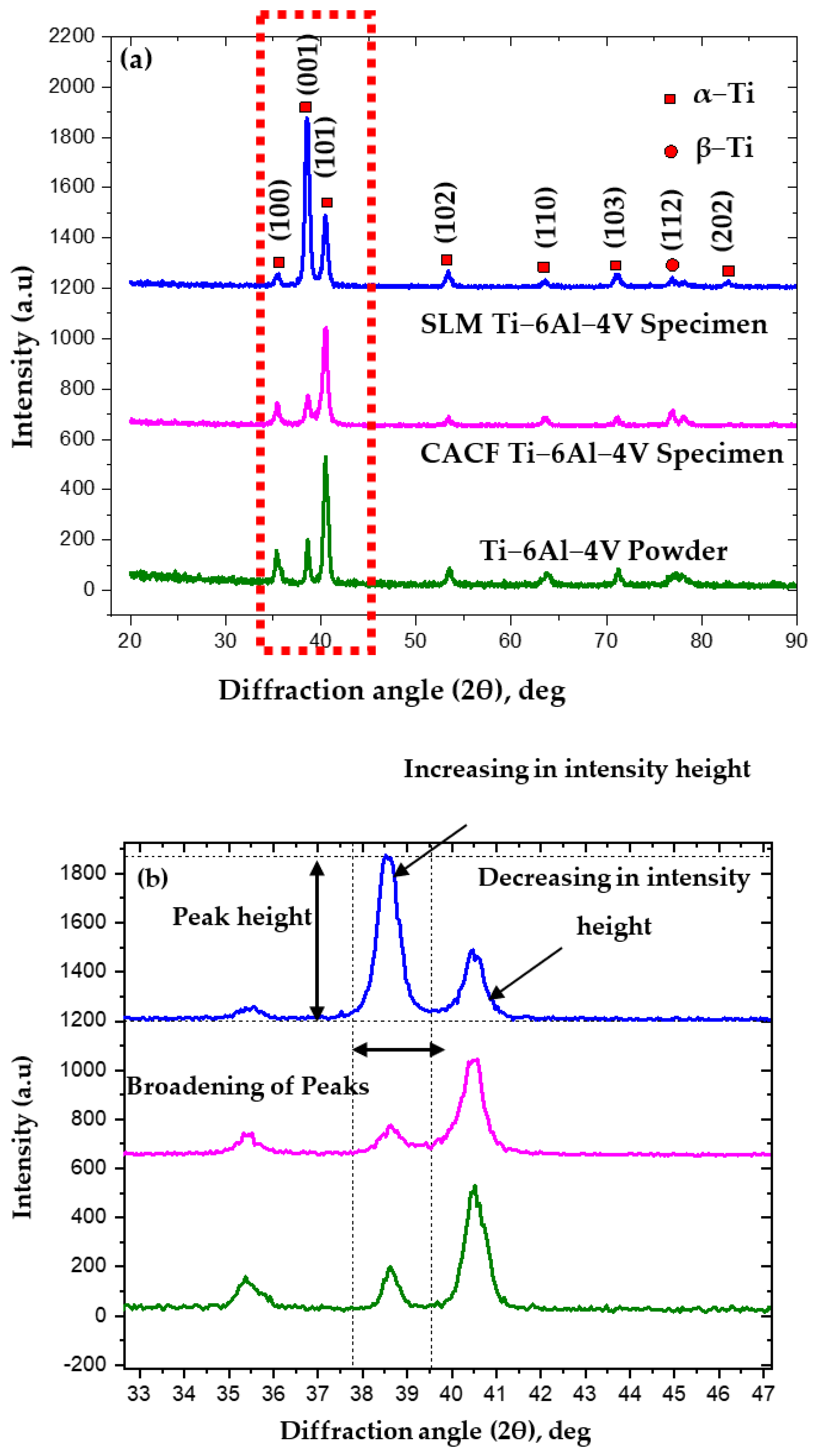


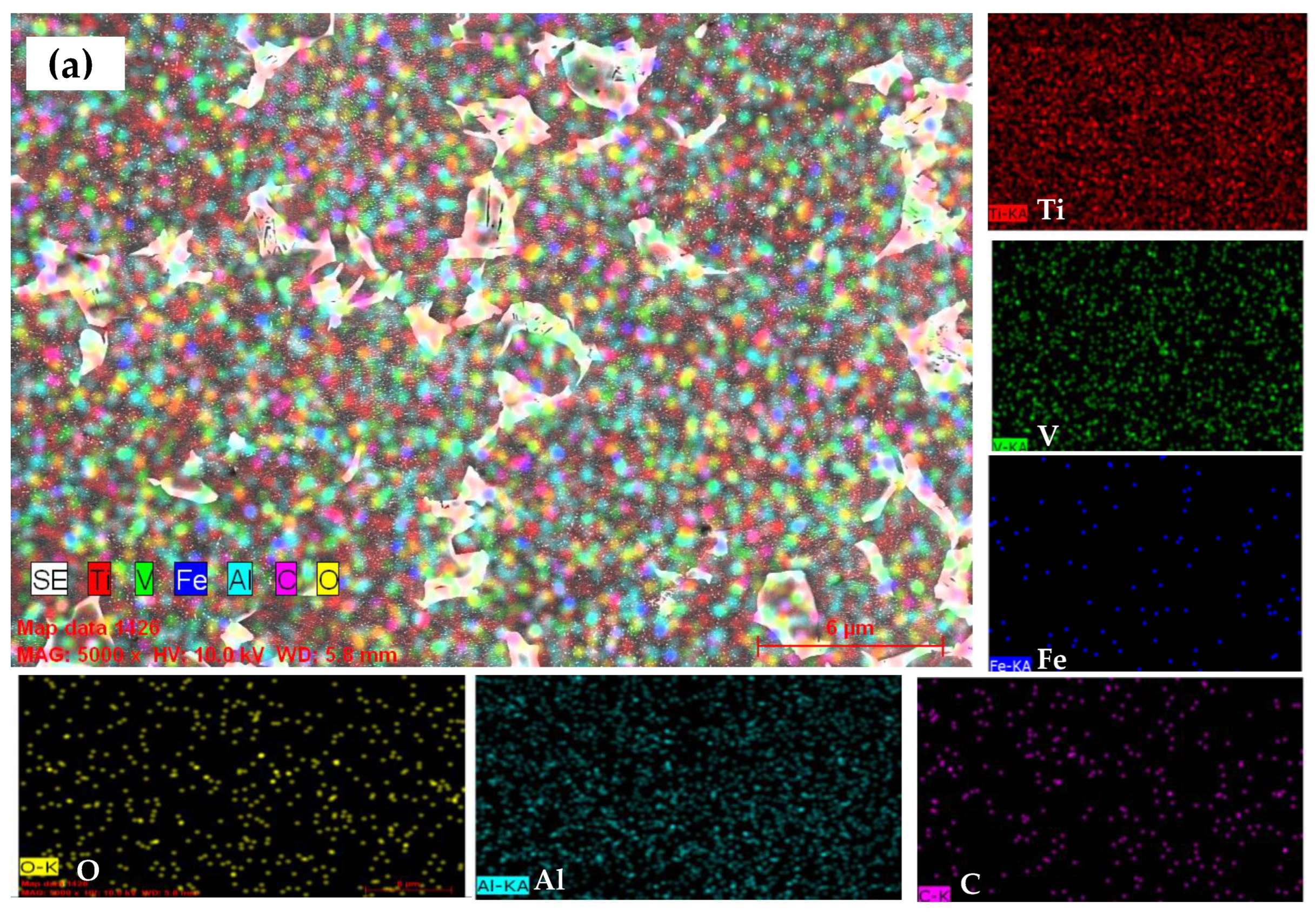
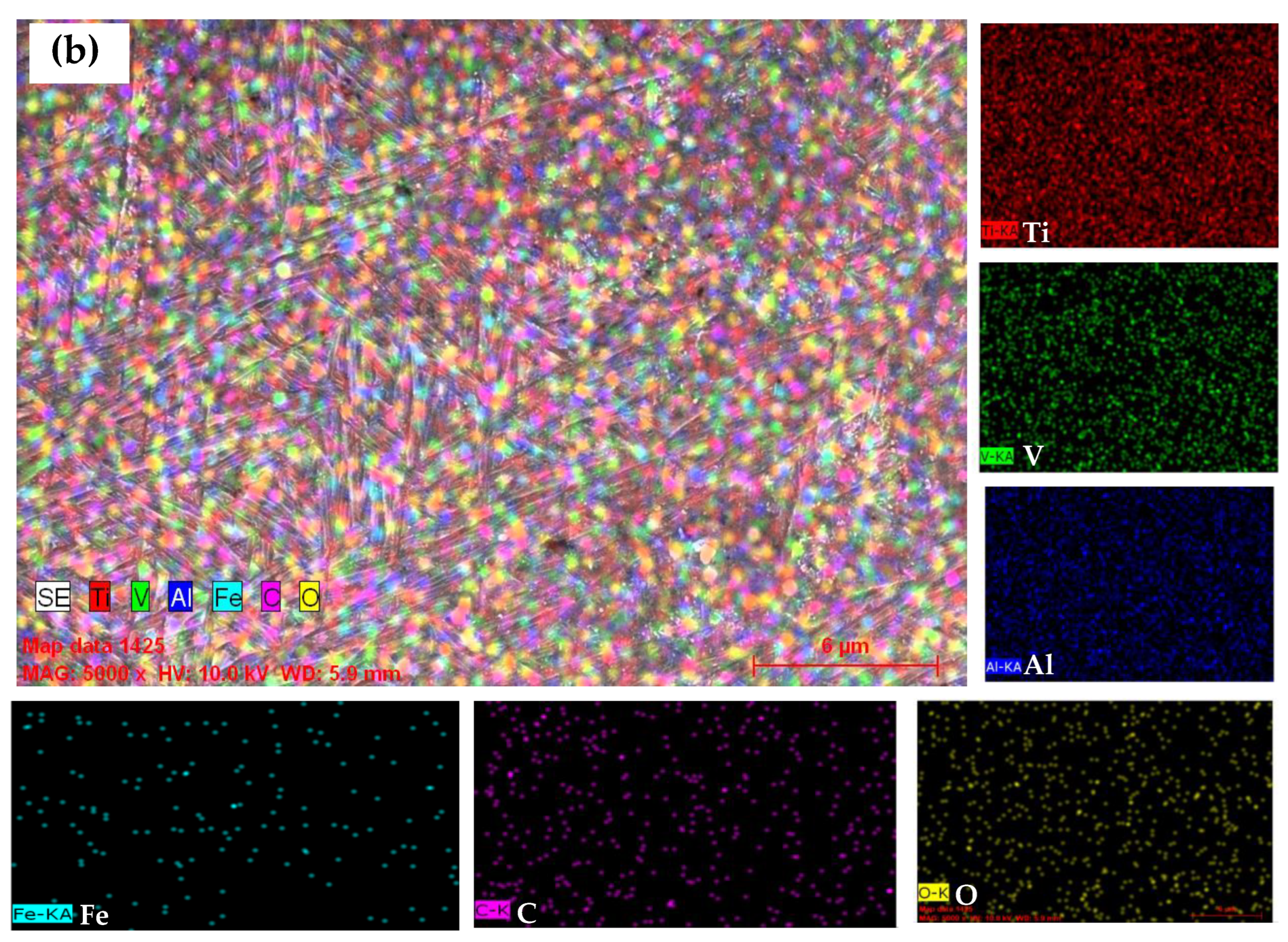

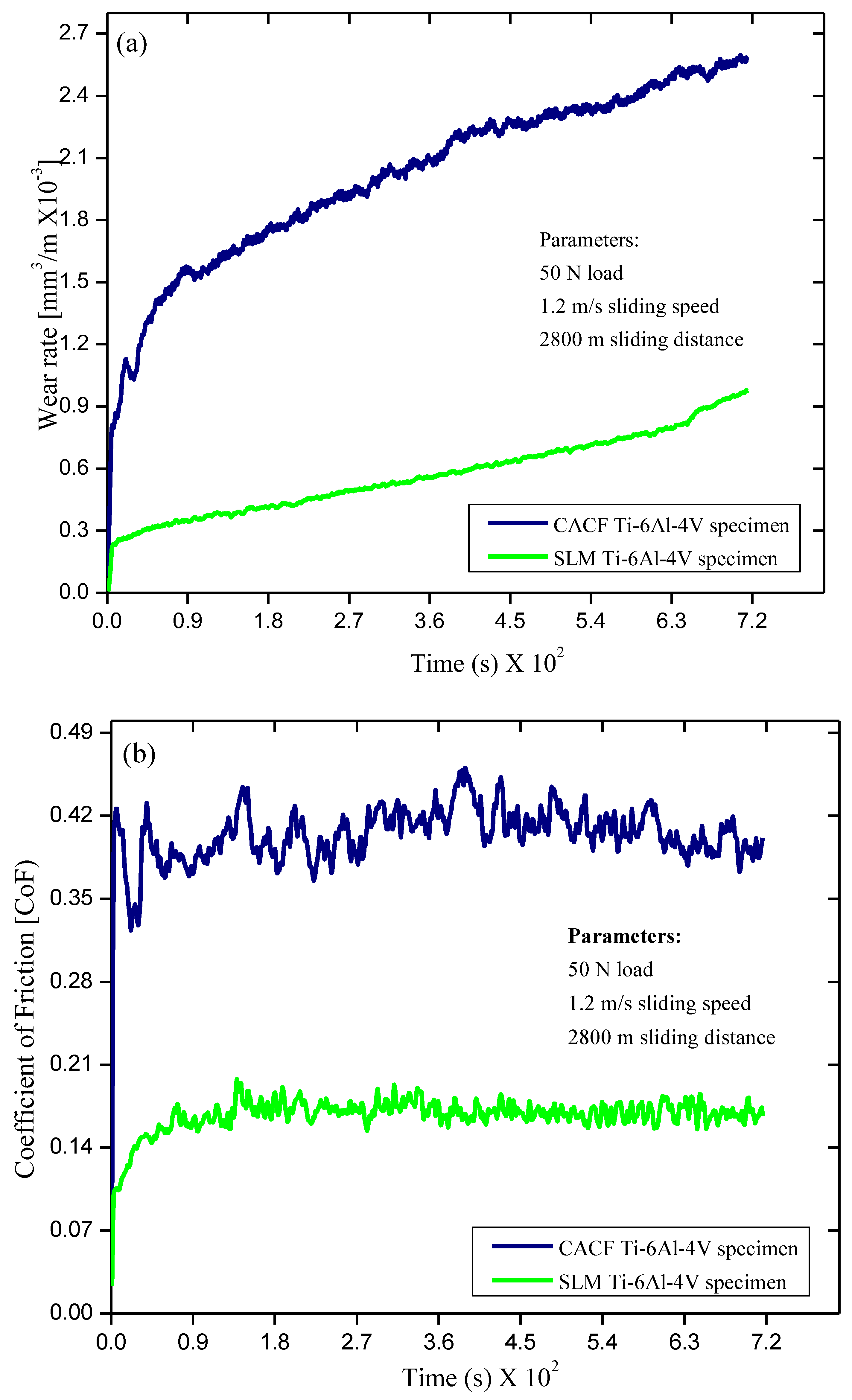
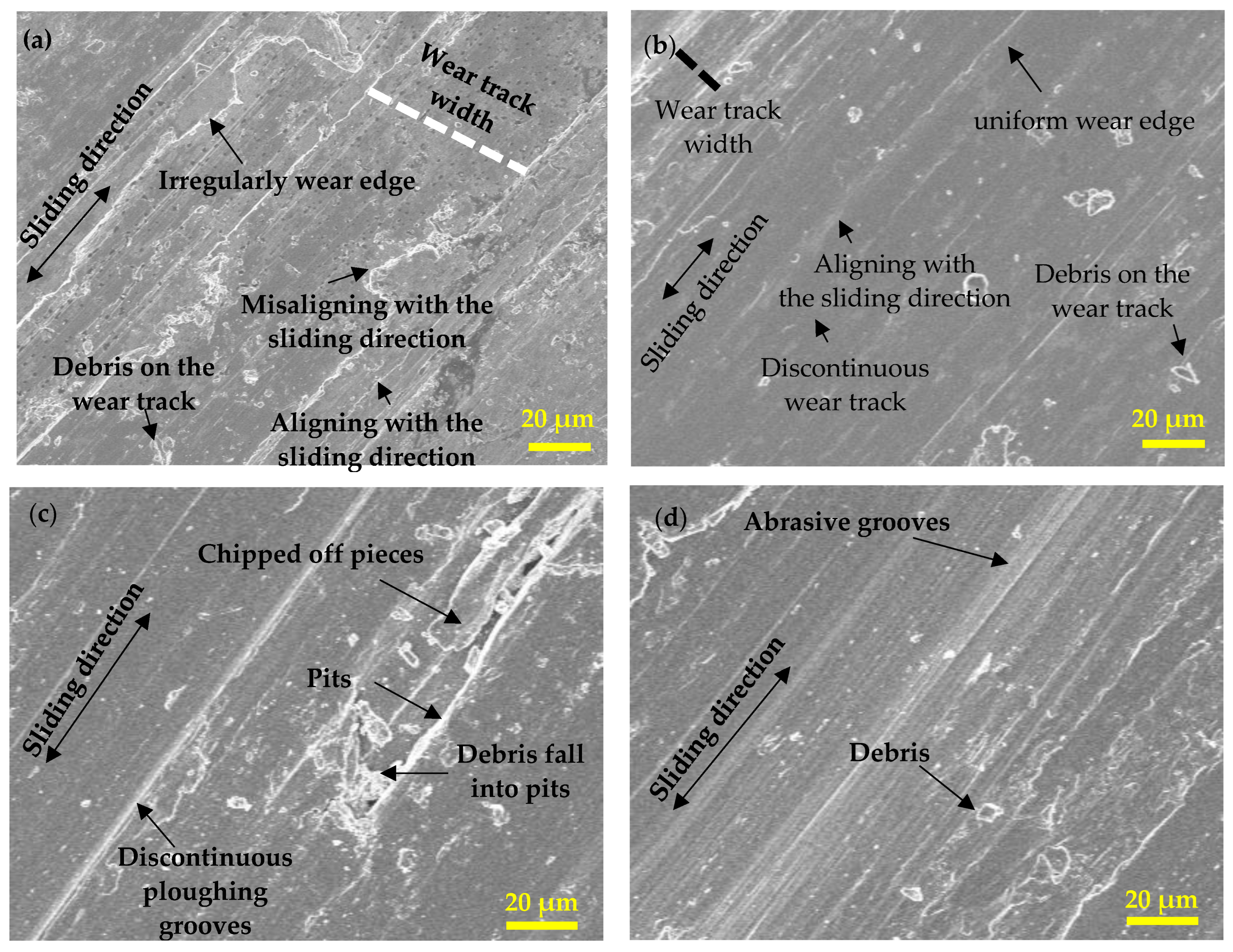



| Input Parameters | Values |
|---|---|
| Powder particle size | 15–53 micron |
| Layer thickness | 0.03 mm |
| Power | 275 watts |
| Laser beam spot size | 100 µm |
| laser travel speed | 1100 mm/s |
| Printing bed temperature | 200 °C |
| Gases used | Ar |
| EDS Analysis Results (In Atomic wt.%) | Ti | Al | V | Fe | C |
|---|---|---|---|---|---|
| Grey region of CACF specimen [Figure 3c] | 81.98 | 10.21 | 4.32 | 2.46 | 1.03 |
| White region of CACF specimen [Figure 3d] | 82.61 | 10.20 | 5.60 | 1.03 | 0.56 |
| Grey region of SLM specimen [Figure 3e] | 86.82 | 6.95 | 3.67 | 1.92 | 0.64 |
| White region of SLM specimen [Figure 3f] | 82.19 | 7.25 | 6.49 | 2.21 | 1.86 |
| EDS Analysis Results (In Atomic wt.%) | Ti | Al | V | Fe | C | O |
|---|---|---|---|---|---|---|
| Overall area of CACF specimen [Figure 9c] | 78.45 | 6.91 | 9.32 | 0.63 | 2.54 | 2.15 |
| Overall area of SLM specimen [Figure 9d] | 75.01 | 5.32 | 4.17 | 5.92 | 1.24 | 8.34 |
| Wear debris of CACF specimen [Figure 9e] | 78.37 | 8.46 | 4.43 | 0.35 | 6.37 | 2.02 |
| Wear debris of SLM specimen [Figure 9f] | 70.61 | 6.02 | 3.68 | 7.23 | 1.97 | 10.49 |
Disclaimer/Publisher’s Note: The statements, opinions and data contained in all publications are solely those of the individual author(s) and contributor(s) and not of MDPI and/or the editor(s). MDPI and/or the editor(s) disclaim responsibility for any injury to people or property resulting from any ideas, methods, instructions or products referred to in the content. |
© 2023 by the authors. Licensee MDPI, Basel, Switzerland. This article is an open access article distributed under the terms and conditions of the Creative Commons Attribution (CC BY) license (https://creativecommons.org/licenses/by/4.0/).
Share and Cite
Jeyaprakash, N.; Yang, C.-H.; Prabu, G.; Radhika, N. Mechanism Correlating Microstructure and Wear Behaviour of Ti-6Al-4V Plate Produced Using Selective Laser Melting. Metals 2023, 13, 575. https://doi.org/10.3390/met13030575
Jeyaprakash N, Yang C-H, Prabu G, Radhika N. Mechanism Correlating Microstructure and Wear Behaviour of Ti-6Al-4V Plate Produced Using Selective Laser Melting. Metals. 2023; 13(3):575. https://doi.org/10.3390/met13030575
Chicago/Turabian StyleJeyaprakash, Natarajan, Che-Hua Yang, Govindarajan Prabu, and Nachimuthu Radhika. 2023. "Mechanism Correlating Microstructure and Wear Behaviour of Ti-6Al-4V Plate Produced Using Selective Laser Melting" Metals 13, no. 3: 575. https://doi.org/10.3390/met13030575





